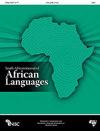Mofokeng’s dramatic play, Senkatana, epitomises intertextuality
IF 0.4
0 LANGUAGE & LINGUISTICS
引用次数: 0
Abstract
SM Mofokeng’s dramatic text Senkatana (1982) is a classic Sesotho tragedy. The drama has been adapted from the well-known Basotho folktale Moshanyana wa Senkatana. There are also certain authors that inspired Mofokeng to create Senkatana. Intertextuality has played an important role in creating Mofokeng’s masterpiece. The protagonist is Senkatana, whose fall is caused by his own good intentions. Audiences and readers develop pity and horror for Senkatana for the situation in which he finds himself. No one can help him emerge from his circumstances, nothing can help him choose the safe way as opposed to the tragic one. Senkatana, the tragic hero, does not make decisions independently, because badimo, the ancestors and God, control his destiny, and he cannot fight badimo and God. The central argument in this article is that Mofokeng’s dramatic text attains meaning from other texts and authors. Senkatana’s meaning appears to be content-bound, but when readers look at its content, it is boundless because it refers to other previous texts. For the purpose of this article, the theory of intertextuality will serve as the point of departure to investigate the manner in which folktale, Greek tragedy, Shakespeare and the Bible generate meaning in the act of Mofokeng’s writing of Senkatana.Mofokeng的戏剧《Senkatana》是互文性的缩影
莫福铿的戏剧文本《仙卡塔那》(1982)是一部典型的塞索托悲剧。该剧改编自著名的巴索托民间故事《摩山亚纳瓦森卡塔纳》。也有一些作家激发了莫佛坑创作《仙卡塔那》的灵感。互文性在莫的代表作创作中发挥了重要作用。主角是森卡塔纳,他的堕落是由于他自己的善意。观众和读者对森卡塔纳所处的处境产生了怜悯和恐惧。没有人能帮助他摆脱困境,没有人能帮他选择安全的方式,而不是悲惨的方式。悲剧英雄森卡塔纳并不是独立决策的,因为祖先和上帝巴迪莫控制着他的命运,他无法与巴迪莫和上帝对抗。本文的中心论点是莫的戏剧文本从其他文本和作者那里获得了意义。Senkatana的含义似乎是有内容限制的,但当读者看到它的内容时,它是无限的,因为它指的是以前的其他文本。本文将以互文性理论为出发点,考察民间故事、希腊悲剧、莎士比亚和《圣经》在莫佛坑的《圣卡塔那》创作过程中产生意义的方式。
本文章由计算机程序翻译,如有差异,请以英文原文为准。
求助全文
约1分钟内获得全文
求助全文
来源期刊

South African Journal of African Languages
LANGUAGE & LINGUISTICS-
CiteScore
0.50
自引率
0.00%
发文量
30
期刊介绍:
The South African Journal of African Languages is a peer-reviewed research journal devoted to the advancement of African (Bantu) and Khoi-San languages and literatures. Papers, book reviews and polemic contributions of a scientific nature in any of the core areas of linguistics, both theoretical (e.g. syntax, phonology, semantics) and applied (e.g. sociolinguistic topics, language teaching, language policy), and literature, based on original research in the context of the African languages, are welcome. The journal is the official mouthpiece of the African Language Association of Southern Africa (ALASA), established in 1979.
 求助内容:
求助内容: 应助结果提醒方式:
应助结果提醒方式:


